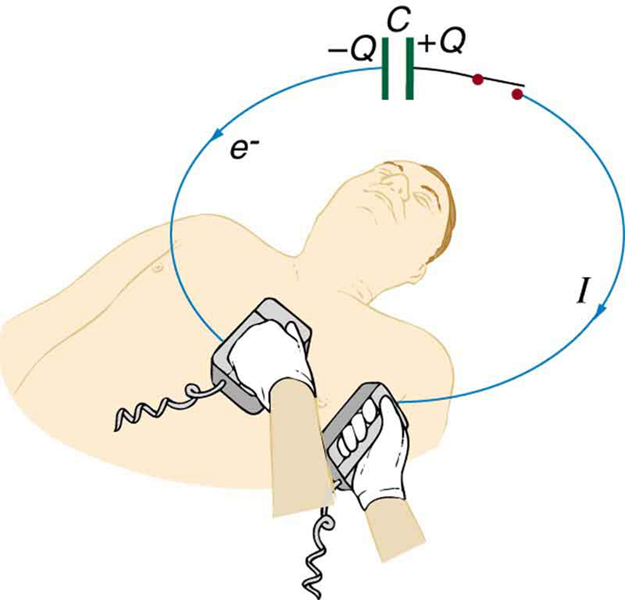| << Chapter < Page | Chapter >> Page > |
Can a wire carry a current and still be neutral—that is, have a total charge of zero? Explain.
Car batteries are rated in ampere-hours ( ). To what physical quantity do ampere-hours correspond (voltage, charge, . . .), and what relationship do ampere-hours have to energy content?
If two different wires having identical cross-sectional areas carry the same current, will the drift velocity be higher or lower in the better conductor? Explain in terms of the equation , by considering how the density of charge carriers relates to whether or not a material is a good conductor.
Why are two conducting paths from a voltage source to an electrical device needed to operate the device?
In cars, one battery terminal is connected to the metal body. How does this allow a single wire to supply current to electrical devices rather than two wires?
Why isn’t a bird sitting on a high-voltage power line electrocuted? Contrast this with the situation in which a large bird hits two wires simultaneously with its wings.
What is the current in milliamperes produced by the solar cells of a pocket calculator through which 4.00 C of charge passes in 4.00 h?
0.278 mA
A total of 600 C of charge passes through a flashlight in 0.500 h. What is the average current?
What is the current when a typical static charge of moves from your finger to a metal doorknob in ?
0.250 A
Find the current when 2.00 nC jumps between your comb and hair over a time interval.
A large lightning bolt had a 20,000-A current and moved 30.0 C of charge. What was its duration?
1.50ms
The 200-A current through a spark plug moves 0.300 mC of charge. How long does the spark last?
(a) A defibrillator sends a 6.00-A current through the chest of a patient by applying a 10,000-V potential as in the figure below. What is the resistance of the path? (b) The defibrillator paddles make contact with the patient through a conducting gel that greatly reduces the path resistance. Discuss the difficulties that would ensue if a larger voltage were used to produce the same current through the patient, but with the path having perhaps 50 times the resistance. (Hint: The current must be about the same, so a higher voltage would imply greater power. Use this equation for power: .)

(a)
(b) If a 50 times larger resistance existed, keeping the current about the same, the power would be increased by a factor of about 50 (based on the equation ), causing much more energy to be transferred to the skin, which could cause serious burns. The gel used reduces the resistance, and therefore reduces the power transferred to the skin.
During open-heart surgery, a defibrillator can be used to bring a patient out of cardiac arrest. The resistance of the path is and a 10.0-mA current is needed. What voltage should be applied?
(a) A defibrillator passes 12.0 A of current through the torso of a person for 0.0100 s. How much charge moves? (b) How many electrons pass through the wires connected to the patient? (See figure two problems earlier.)
(a) 0.120 C
(b)
A clock battery wears out after moving 10,000 C of charge through the clock at a rate of 0.500 mA. (a) How long did the clock run? (b) How many electrons per second flowed?
The batteries of a submerged non-nuclear submarine supply 1000 A at full speed ahead. How long does it take to move Avogadro’s number ( ) of electrons at this rate?
96.3 s
Electron guns are used in X-ray tubes. The electrons are accelerated through a relatively large voltage and directed onto a metal target, producing X-rays. (a) How many electrons per second strike the target if the current is 0.500 mA? (b) What charge strikes the target in 0.750 s?
A large cyclotron directs a beam of nuclei onto a target with a beam current of 0.250 mA. (a) How many nuclei per second is this? (b) How long does it take for 1.00 C to strike the target? (c) How long before 1.00 mol of nuclei strike the target?
(a)
(b)
(c)
Repeat the above example on [link] , but for a wire made of silver and given there is one free electron per silver atom.
Using the results of the above example on [link] , find the drift velocity in a copper wire of twice the diameter and carrying 20.0 A.
A 14-gauge copper wire has a diameter of 1.628 mm. What magnitude current flows when the drift velocity is 1.00 mm/s? (See above example on [link] for useful information.)
SPEAR, a storage ring about 72.0 m in diameter at the Stanford Linear Accelerator (closed in 2009), has a 20.0-A circulating beam of electrons that are moving at nearly the speed of light. (See [link] .) How many electrons are in the beam?


Notification Switch
Would you like to follow the 'Physics of the world around us' conversation and receive update notifications?